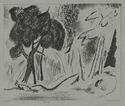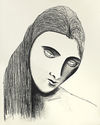
19th, 20th & 21st Century Fine Prints
707-546-7352 · fax 707-546-7924 · web: www.annexgalleries.com · email: artannex@aol.com
Walt Kuhn Biography
Walt Kuhn
American
1877–1949
Biography
Painter and printmaker Walter Francis Kuhn was born in Brooklyn, New York, on October 27, 1877, the only sibling of eight to survive childhood. Though he showed a propensity toward art, it wasn't considered an option for a young man in a working class family, and after one year at the Broolyn Polytechnic Institute in 1896, he took up a job as a bike repairman and professional racer at summer fairs. He would draw on his own time, however; while still a teenager, he sold one of his works to a magazine, an event which remained an inspiration to him.
In 1899, Kuhn left for San Francisco, California, where he took an illustration job with the satirical weekly magazine, WASP, founded by the Korbel brothers (later of sparkling wine fame). After two years, feeling as if his studies were incomplete in comparison with his wealthier peers, he traveled to Europe to research Old Masters, leaving for Paris in 1901. He took classes at the Academie Colarossi and then the Royal Academy in Munich, also taking private lessons from Heinrich von Zugel. He returned to New York in 1903, looking to find dual work as a serious fine artist and an illustrator and cartoonist. He took up a job as an illustrator for Life magazine and in 1905 he participated in his first exhibition at the Salmangundi Club. In 1908 he worked briefly for the New York School of Art after it relocated to Fort Lee, New Jersey, but he returned to New York within the year where he held his first solo exhibition in 1909.
He continued to learn in an autodidactic manner in his spare time and would use repetitive excercises to achieve what he felt did not come naturally to him. In one instance, he drew over 3,000 studies of the nude in a few months. Additionally, he began to work on his networking and entrepreneur skills. He became a member of the American Association of Sculptors and Painters, and in 1910, began to formulate a plan for what would become the famed Armory Show. Known as the first major international exhibition of Modern artists to take place in the United States, the 1913 event was massively successful owing in part to Kuhn's keen publicity sense, and it radically transformed the American art world's perception of Modernism. Interestingly, despite his drive to promote contemporary and often controversial art movements in his early career, his later career was negatively defined by his percieved conservatism, when he decried what he viewed as the growing preference for Abstraction and a lack of support for post-WWI American artists.
Kuhn's style evolved in the 1910s through the late 1920s to encompass elements of Cubism, Fauvism, and other Post-Impressionism styles but his subject matter stayed virtually the same: portraits and images of figures in landscapes or cityscapes that displayed a deep intensity of emotion. While supporting the forward momentum of art theory and modernism, Kuhn often eschewed labels for his own work, and preferred that each piece speak for itself.
In the 1920s Kuhn worked as an instructor at the Art Students League of New York, following a debilitating ulcer and prolonged recovery. A main source of inspiration to him, which would remain with him throughout his career, was city life and scenes of entertainment and performers. Themes of dance, circus clowns, and portraits of everyday people became recurrent and their startling frankness, with the sitter often looking directly at the viewer, earned Kuhn critical success. In 1933 held his first retrospective, and he would continue to work throughout the rest of the decade. Despite the positive reception for his work by the public and art critics, Kuhn was his own harshest critic and destroyed more works than he kept.
In the 1940s Kuhn's health took a turn for the worse, and physical and mental illness rendered him unable to care for himself. He was committed to Bellvue Hospital in New York and later transferred to a home in White Plains, where he died in 1949.
Kuhn's work can be found in the collections of the Museum of Modern Art, the Metropolitan Museum of Art, the National Gallery of Art, Hirschhorn Museum and Sculpture Garden, the Art Institute of Chicago, and the Los Angeles County Museum, among others.




